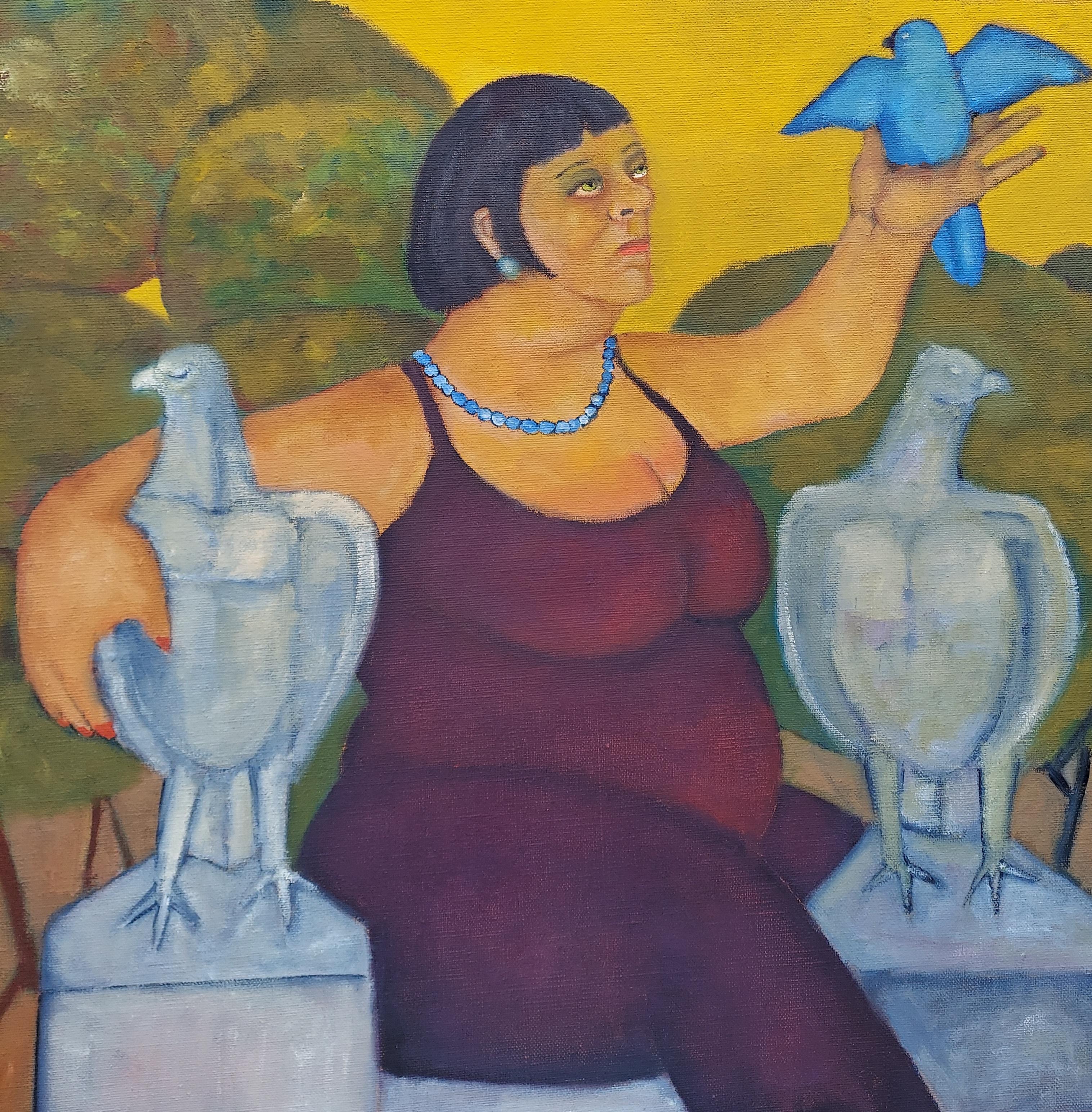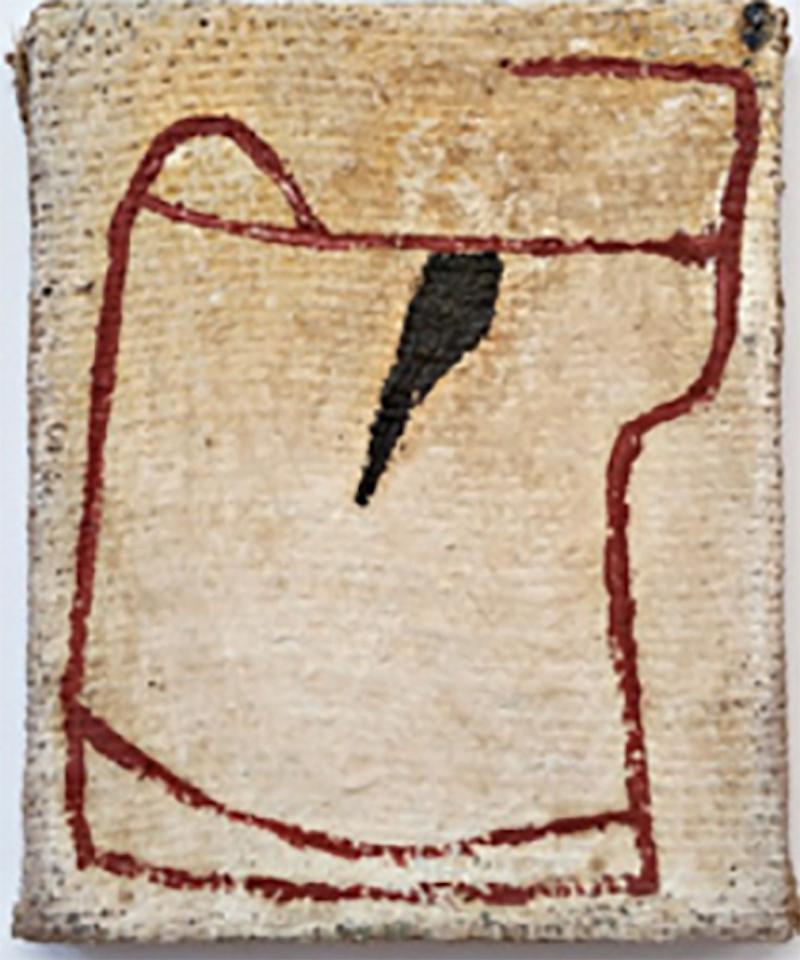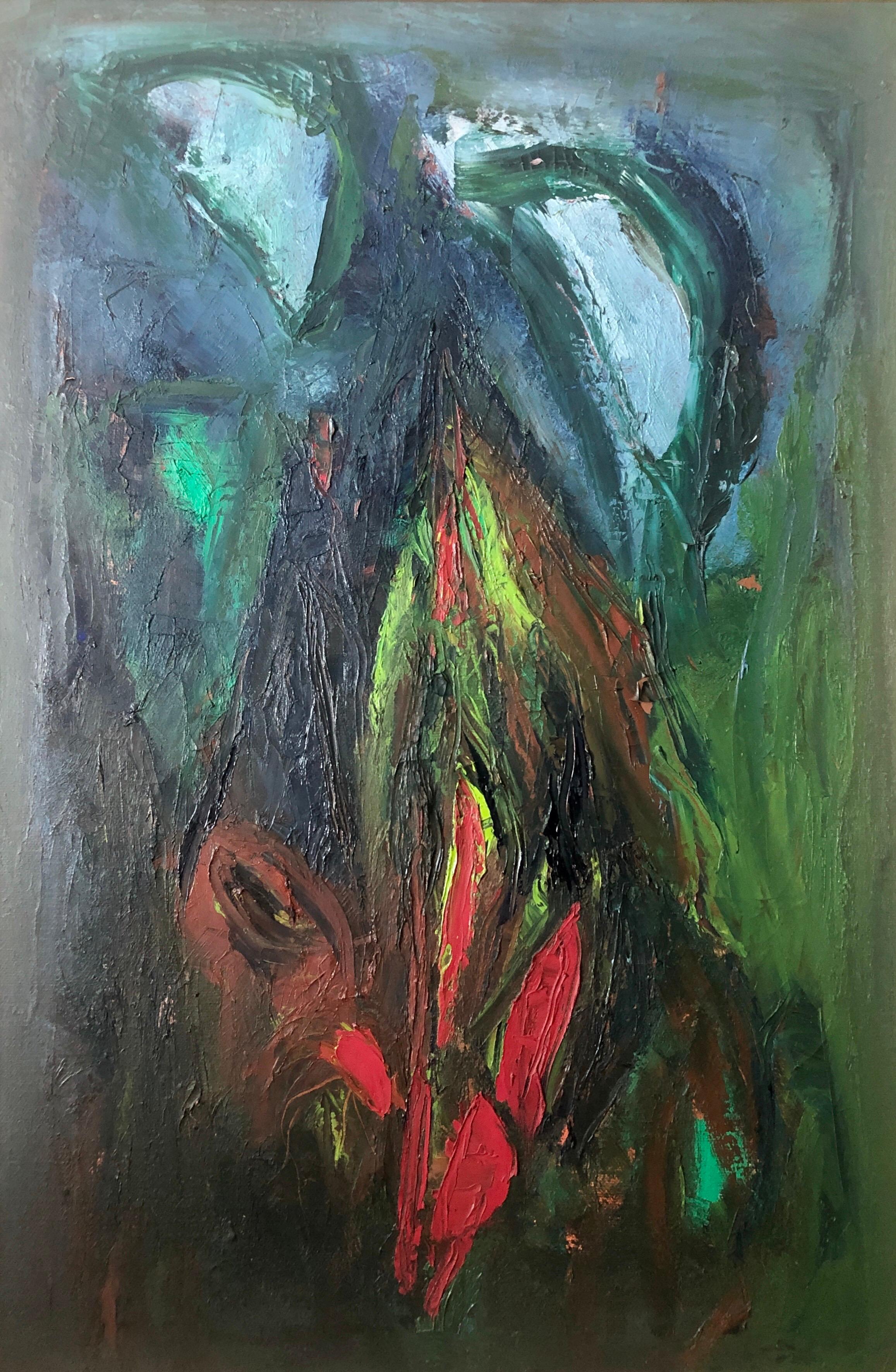Items Similar to Aerial With Boat Wake
Want more images or videos?
Request additional images or videos from the seller
1 of 5
Adam StrausAerial With Boat Wake2015
2015
About the Item
Adam Straus is an American artist based in Riverhead, NY. Starting as a photographer and sculptor in the the late 70's and early 80's, he began making small paintings in 1986 of nocturnal landscapes inspired by his surroundings in north Florida. These paintings were often instilled with a dark humor, social commentary, and framed in the sheet lead he had been using on sculpture. Straus creates paintings that are seductive and gloomily romantic with views of skylines and seascapes, fields and mountains. The paintings go beyond contemplation, and present his concerns about the cruel reality of our planet. In his oils, Straus represents the struggle and survival of mankind and mankind’s effect on nature.
His technique has evolved throughout the years, but always with a marked personality. In framing the paintings in lead or steel he adds a unique touch, and more recently, his pixelating technique evokes the particulate matter suspended in the air and water.
- Creator:Adam Straus (1956)
- Creation Year:2015
- Dimensions:Height: 24 in (60.96 cm)Width: 24 in (60.96 cm)
- Medium:
- Period:
- Condition:
- Gallery Location:New York, NY
- Reference Number:1stDibs: LU8512552262
About the Seller
5.0
Recognized Seller
These prestigious sellers are industry leaders and represent the highest echelon for item quality and design.
Established in 1981
1stDibs seller since 2011
33 sales on 1stDibs
Typical response time: 1 to 2 days
Associations
Art Dealers Association of America
- ShippingRetrieving quote...Ships From: New York, NY
- Return PolicyThis item cannot be returned.
More From This SellerView All
- WINTER WOODS 2By Adam StrausLocated in New York, NYlandscape paintings of woods in Winter in oil on jute adhered to canvasCategory
2010s Contemporary Landscape Paintings
MaterialsCanvas, Jute, Oil
- The MimeBy Paton MillerLocated in New York, NYOil painting of a mime and a mother and child darkCategory
1980s Contemporary Figurative Paintings
MaterialsCanvas, Oil
- UNTITLEDBy Louisa ChaseLocated in New York, NYfantastical landscapeCategory
1980s 85 New Wave Abstract Paintings
MaterialsCanvas, Oil
- TRANSPARENT GREEN SQUARESLocated in New York, NYlarge abstract oil painting on canvas green orange brownCategory
1980s Contemporary Abstract Paintings
MaterialsCanvas, Oil
- LANDSCAPEBy John AlexanderLocated in New York, NYFall landscape of field of wheat or long grass. yellow, beige and brown colors. AmericanCategory
Late 20th Century American Realist Landscape Paintings
MaterialsCanvas, Oil
- INTO THE FORESTBy Julie HedrickLocated in New York, NYMaterials
Canvas, Oil
You May Also Like
- Bluebird Spring garden setting large female figure soft warm Grey violet yellowBy Stephen BassoLocated in Brooklyn, NYThis is an oil painting on jute canvas mounted on a cradled wood board. It is signed and dated by the artist on reverse. The texture is rough yet dense with a strong balance of light...Category
2010s Outsider Art Figurative Paintings
MaterialsJute, Wood, Oil, Canvas
- Me and My ArrowBy Rick LewisLocated in Greenwich, CTMe and My Arrow Oil On Jute, Laid On Canvas 10" x 8" I am a visual artist whose work investigates small and large -scale abstraction primarily in the medium of painting employing th...Category
21st Century and Contemporary Abstract Abstract Paintings
MaterialsCanvas, Jute, Cotton Canvas, Oil
- Large Colorful MCM Abstract Expressionist Oil Painting Modernist Ralph RosenborgBy Ralph RosenborgLocated in Surfside, FLRalph Rosenborg (American, 1913-1992) Mountain Weed with Two Clouds, oil on jute canvas, canvas is hand signed recto and verso, artists label and Snyder Fine Art gallery label, The painting is dated 1965. Dimensions: 24 x 36 canvas, framed size is 44.5 x 32.5. Ralph Rosenborg (1913–1992) was an American artist whose paintings were described as both expressionist and abstract and who was a colleague of the New York Abstract Expressionists in the 1940s and 1950s. Unlike them, however, he preferred to make small works and tended to explicitly draw upon natural forms and figures for his abstract subjects. Called a "highly personal artist," he developed a unique style that was considered to be both mystical and magic. His career was exceptionally long, covering more than 50 years. Rosenborg was born in Brooklyn, New York, on June 9, 1913. In 1929, while he was a high school student, he began to work with the designer, artist, and instructor, Henriette Reiss. When Rosenborg encountered her, Reiss was serving as an instructor for the School Art League in the American Museum of Natural History. She was then engaged in instructing both students and their teachers in the city school system by a method she called Rhythmic Design. She believed inspiration for abstract designs could be found in rhythms—rhythms that could be perceived in ordinary perceptions much as they are when listening to music. In May 1930 Reiss selected a drawing by Rosenborg to be shown in an exhibition of creative design by City high school students. From 1930 to 1933, aged 17 to 20, Rosenborg studied with Reiss in what Vivien Raynor of the New York Times called a "pupil-apprentice" relationship. During this time she instructed him in music appreciation, literature, and art history as well as giving technical training in art. In April 1934 Rosenborg was one of 1,500 artists to participate in the annual Salons of America exhibition, which was held that year in Rockefeller Center RCA Building. Each paid two dollars for the privilege of hanging up to three works and none was given prominence over the others. The New York Times reported that by the time the show closed a month later, some 30,000 people had viewed it. The following year he was given a solo exhibition (his first) at the Lounge Gallery of the Eighth Street Playhouse. The year after that he participated in a group show held by the Municipal Art Committee and in 1937 was given a second solo exhibition, this time in the Artists Gallery. That year he also became a founding member of and participated in a group show held by American Abstract Artists, a loose assembly of artists that aimed to promote abstract art and artists in New York. Its founders included Josef Albers, Ilya Bolotowsky, Werner Drewes, Ibram Lassaw, Mercedes Matter, Louis Schanker, Vaclav Vytlacil and Rudolph Weisenborn. At roughly the same time Rosenborg associated himself with a group of abstractionists that called itself "The Ten" (It included Ben-Zion, Mark Rothko, Adolph Gottlieb and Joe Solman) and in May 1938 joined with its other members in what would be his first appearance in a commercial gallery: the Gallery Georgette Passedoit. In 1938 he his work appeared in a group show at the Lounge Gallery, in 1939 in group shows at the Artists Gallery and at the Bonestell Gallery with David Burliuk, Earl Kerkam, Karl Knaths and Jean Liberte...Category
1960s Abstract Expressionist Abstract Paintings
MaterialsJute, Oil, Canvas
- Large Colorful Abstract Expressionist Oil Painting Modernist Beach LandscapeBy Ralph RosenborgLocated in Surfside, FLRalph Rosenborg (American, 1913-1992) "American Landscape, Sky and Shore, 1973" Oil on canvas. Signed 'Rosenborg' (lower right). Titled (verso). 30 x 40 in Ralph Rosenborg (1913–1992) was an American artist whose paintings were described as both expressionist and abstract and who was a colleague of the New York Abstract Expressionists in the 1940s and 1950s. Unlike them, however, he preferred to make small works and tended to explicitly draw upon natural forms and figures for his abstract subjects. Called a "highly personal artist," he developed a unique style that was considered to be both mystical and magic. His career was exceptionally long, covering more than 50 years. Rosenborg was born in Brooklyn, New York, on June 9, 1913. In 1929, while he was a high school student, he began to work with the designer, artist, and instructor, Henriette Reiss. When Rosenborg encountered her, Reiss was serving as an instructor for the School Art League in the American Museum of Natural History. She was then engaged in instructing both students and their teachers in the city school system by a method she called Rhythmic Design. She believed inspiration for abstract designs could be found in rhythms—rhythms that could be perceived in ordinary perceptions much as they are when listening to music. In May 1930 Reiss selected a drawing by Rosenborg to be shown in an exhibition of creative design by City high school students. From 1930 to 1933, aged 17 to 20, Rosenborg studied with Reiss in what Vivien Raynor of the New York Times called a "pupil-apprentice" relationship. During this time she instructed him in music appreciation, literature, and art history as well as giving technical training in art. In April 1934 Rosenborg was one of 1,500 artists to participate in the annual Salons of America exhibition, which was held that year in Rockefeller Center RCA Building. Each paid two dollars for the privilege of hanging up to three works and none was given prominence over the others. The New York Times reported that by the time the show closed a month later, some 30,000 people had viewed it. The following year he was given a solo exhibition (his first) at the Lounge Gallery of the Eighth Street Playhouse. The year after that he participated in a group show held by the Municipal Art Committee and in 1937 was given a second solo exhibition, this time in the Artists Gallery. That year he also became a founding member of and participated in a group show held by American Abstract Artists, a loose assembly of artists that aimed to promote abstract art and artists in New York. Its founders included Josef Albers, Ilya Bolotowsky, Werner Drewes, Ibram Lassaw, Mercedes Matter, Louis Schanker, Vaclav Vytlacil and Rudolph Weisenborn. At roughly the same time Rosenborg associated himself with a group of abstractionists that called itself "The Ten" (It included Ben-Zion, Mark Rothko, Adolph Gottlieb and Joe Solman) and in May 1938 joined with its other members in what would be his first appearance in a commercial gallery: the Gallery Georgette Passedoit. In 1938 he his work appeared in a group show at the Lounge Gallery, in 1939 in group shows at the Artists Gallery and at the Bonestell Gallery with David Burliuk, Earl Kerkam, Karl Knaths and Jean Liberte...Category
1960s Abstract Expressionist Abstract Paintings
MaterialsCanvas, Oil, Jute
- The beauty of silenceLocated in Sempach, LUVertical composition made on canvas on cardboard with acrylic paints, as well as texture paste with sand and coffee, textiles, jute fiber. It is covered with a durable acrylic varnis...Category
2010s Abstract Mixed Media
MaterialsOil, Fabric, Acrylic, Coffee, Lacquer, Linen, Jute, Canvas, Textile
- Stephen Edlich CollageBy Stephen EdlichLocated in Newport Beach, CAA signed, dated, 1970’s, acrylic, charcoal, paper and jute collage-on-canvas by notable, listed American artist, Stephen Edlich (1944-1989). Inscribed Majo, 1976-1977 on the reverse....Category
1970s More Art
MaterialsCanvas, Jute, Paper, Charcoal, Acrylic




